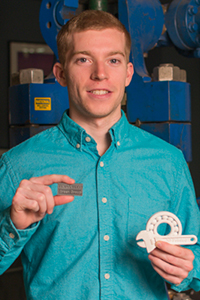Texas Tech Research Focuses on Strengthening 3D Printing Materials

Graduate student Brandon Sweeney. Courtesy of Texas Tech.
Latest News
March 13, 2014
No matter how large or small the 3D printer, how quickly it can print and at what resolution, the most important element in additive manufacturing (AM) is material. As is the case in most manufacturing, half of the job of building a part with AM is deciding on the proper material to use. In many cases the simplest material, plastic filament, is really only useful for prototyping or promotions.
Brandon Sweeney, a chemical engineering graduate student at Texas Tech, thinks plastic can do better. Rather than print out multiple prototypes that are then, at best, recycled, Sweeney wants a prototype that could then be used in the field most of the time. Sweeney and his fellow researchers at Texas Tech are working on a method to improve the strength and durability of plastic parts.

The foundation of Sweeney’s work is carbon nanotubes. Each nanotube is stronger than steel, and will bond with other materials if heated. The research team surrounded standard plastic filament with carbon nanotubes, then fed the material into a 3D printer. The carbon nanotubes became sandwiched between layers of plastic as the AM process built an object. A finished object was then microwaved for a short period, forcing the carbon nanotubes to bond with the filament.
Normally, the seams where each strata of plastic material meets the next are the weakest point in a completed build. The bond formed between the carbon nanotubes and the plastic filament results in a finished object that is more durable than prints created using plastic filament alone.
“We now have a provisional patent and are working to do publications and develop our product in industry,” Sweeney told the Daily Toreador. “We’re also seeking industrial partners and funding for the research. We’d really like to buy a nicer printer, more materials and bring on more students to assist in the project.”
According to the researchers, the finished product is light and strong, and durable enough for industrial use. Sweeney has mentioned NASA as one of the groups that might be interested in his work, using reinforced plastic as part of its numerous experiments with AM outside the Earth’s atmosphere.
Below you’ll find a TEDx Talk featuring Sweeney speaking about 3D printing and his research.
Sources: TEDx, Daily Toreador
Subscribe to our FREE magazine, FREE email newsletters or both!
Latest News
About the Author
John NewmanJohn Newman is a Digital Engineering contributor who focuses on 3D printing. Contact him via [email protected] and read his posts on Rapid Ready Technology.
Follow DE





